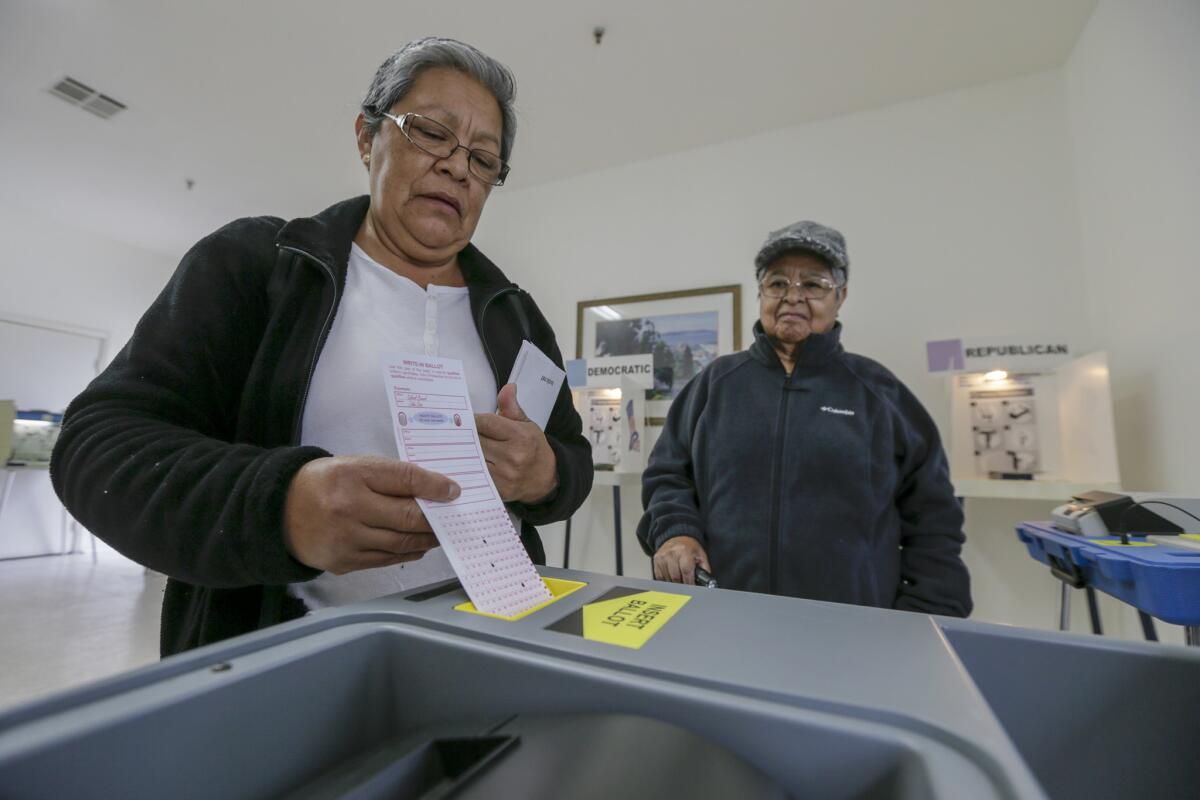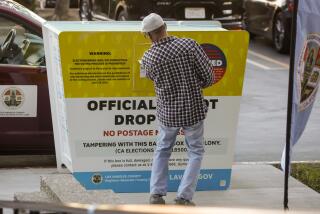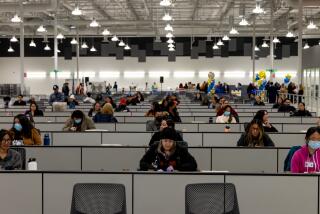Voting will never be quite the same in California if lawmakers pass reforms

Sweeping legislation at the state Capitol would make the future of California elections dependent on a major expansion of absentee ballots, one that would give local officials the power to close thousands of neighborhood polling places.
In their place, counties would open temporary elections offices known as “vote centers” sprinkled throughout communities, locations offering a wide variety of elections services including early voting and same-day voter registration as well as a limited number of in-person voting booths.
“We’re trying to make it easier for people to participate, given the complexities of modern life,” said state Sen. Ben Allen (D-Santa Monica), the author of Senate Bill 450.
The proposal was passed by the Assembly on Tuesday on a party-line vote. It now heads to the state Senate and faces an Aug. 31 deadline to make it to Gov. Jerry Brown for his ultimate signature or veto.
Allen and SB 450’s supporters say the plan represents a significant rethinking of the election experience for Californians. They point out that the many complaints from voters during the June primary — including polling place mistakes and registration errors — are perhaps the best argument for why change is long overdue.
“I think it was very clear the June primary really exposed the weaknesses in our current system,” said Dean Logan, registrar of voters in Los Angeles County. “Our current system and infrastructure are failing.”
SB 450 would offer each of California’s 58 counties the chance to embrace an alternative to traditional elections. In most of those counties, every registered voter would receive a ballot in the mail and polling places would be scrapped. Voters would be able to turn in ballots either at secure drop boxes placed around the county or at the new “vote center” locations.
Sign up for our daily Essential Politics newsletter »
Some of those vote centers would be open at least 10 days before election day, and would allow last-minute registration, a check of existing registration status and the ability to cast a vote in person even if the voter lives in a different city inside county lines. The bill says counties should work together at transporting the ballot of a voter who lives in Ventura County, for example, and mistakenly casts a ballot in Kern County.
“From a voter choice standpoint, all of a sudden you have the choice to go any vote center in your county,” said Secretary of State Alex Padilla, who is urging legislators to send the bill to the governor’s desk. The bill is slated to get its final vote in the Assembly this week, and although lawmakers have been generally supportive, many have said they want to see the final details before making a decision.
Unlike traditional polling places, the vote centers are envisioned as staffed by paid workers with more than the few hours of training normally given to temporary poll workers. Elections officials who have endorsed SB 450 say they envision the sites as one-stop-shopping for voters in convenient locations like retail districts and downtown business zones.
I think it was very clear the June primary really exposed the weaknesses in our current system.
— Dean Logan, registrar of voters in Los Angeles County
Logan said he could even see a few mobile vote centers set up for a pre-election weekend at places like the Rose Bowl.
“This is an entirely new model of voting that’s designed with the voter in mind,” he said.
Still, SB 450 envisions far fewer vote centers than the polling places mandated by existing law. Even though vote centers would be open for more days, in some cases it could mean a 90% reduction in locations where a voter can cast an in-person ballot on election day.
The formulas in the bill language would allow Los Angeles County, which had more than 4,500 neighborhood polling places June 7, to open as few as 100 early vote centers for elections starting in 2020. In the final three days of early voting and on election day itself, there would need to be about 500 vote centers spread throughout the county.
“I’m frankly surprised that there has not been a more robust discussion in the Legislature about whether it’s a good idea to eliminate polling places,” said Kim Alexander, president of the nonpartisan California Voter Foundation.
Although her organization is officially neutral on SB 450, Alexander said such a major change might have been better crafted as a pilot project in a select few counties to see how voters would react — and not something that, if signed into law, could be used in every county in California in as few as four years.
The proposal was inspired by Colorado’s move from traditional polling places in 2013. But unlike Colorado, the California shift would allow counties to decide between “opting in” or continuing to conduct traditional elections — a concession supporters admit was due to the cost of a statewide mandate, and a flexibility that Alexander said could prove troublesome.
Are you an independent voter in California? Not if you checked this box »
“Some counties will adopt this new model and others will not,” she said. “We think this could create more voter confusion.”
If it becomes law, SB 450 would allow for only gradual change. A handful of counties including Orange County would be allowed to adopt the new system for the 2018 elections. All other counties would be allowed to replace polling places with vote centers in 2020.
Los Angeles County, home to as many voters as some U.S. states, would be treated differently from every other county. Although the county could begin eliminating polling places as soon as 2020, SB 450 does not require every one of its voters to be mailed a ballot until 2024. That would mean over four years, some Los Angeles County residents would be forced to use one of the vote centers to cast a ballot.
Logan said that he’s heard the criticisms that too few vote centers in California’s most traffic-plagued region could leave Los Angeles voters with too few options, and that it was likely the county would offer substantially more than the 500 mandated facilities.
“There are some unknowns in this, but the current model is underperforming,” Logan said. Los Angeles County’s turnout was one of the state’s lowest in June, with fewer than 42% of registered voters casting a ballot.
“We’ve got to try something,” he said.
A key question for lawmakers and researchers is whether enough California voters are willing to cast ballots at home to make SB 450’s hopes for efficiency and flexibility pencil out. Final election statistics show 59% of ballots were cast by mail in June.
A survey by UC Davis’ California Civic Engagement Project found young voters and Latino voters both used voting by mail less frequently in 2014 than their counterparts in the state’s electorate. Latino voters in Los Angeles County, according to the report, were among the least likely voters in the state to cast ballots by mail.
Mindy Romero, director of the UC Davis project, said there is a “trust” issue with many Latino voters in assuring their vote will make it through the mail and count.
“When they go in person, they know they’ve actually cast their ballot,” she said.
Supporters of SB 450 and elections officials said the key to such a major change in the election system is an intense and far-reaching voter education effort. The bill mandates new county efforts to explain the system to voters, though it leaves many of the details to local officials.
“What we’re doing is empowering each and every county in California,” Padilla said. “I believe it will be a permanent change for the better.”
Follow @johnmyers on Twitter, sign up for our daily Essential Politics newsletter and listen to the weekly California Politics Podcast
ALSO:
Some say California needs statewide rules for provisional ballots
‘Confusing’ California primary on June 7 ends on a sour note
Track this and other California legislation
UPDATES:
2:10 p.m.: This story was updated to reflect the bill’s passage in the Assembly.
This story was originally published at 12:05 a.m.
More to Read
Get the L.A. Times Politics newsletter
Deeply reported insights into legislation, politics and policy from Sacramento, Washington and beyond. In your inbox three times per week.
You may occasionally receive promotional content from the Los Angeles Times.







